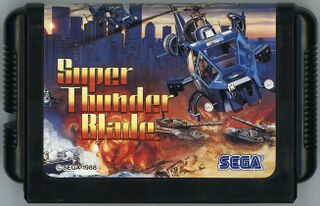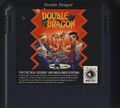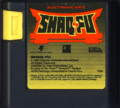Mega Drive cartridges
From Sega Retro

Mega Drive cartridges are the primary storage medium for the Sega Mega Drive.
Contents
Design
The Mega Drive runs games housed in plastic cartridges uniquely shaped to fit the system. Though the technology exists within the console to run Sega Master System games, the Power Base Converter is required to convert between the differing pin connections and slot sizes.
Official Mega Drive cartridges are smaller than their Master System/Mark III counterparts, with rounded edges and bigger labels layered over the top and front of the cartridge.
As with the Master System, Sega-manufactured Japanese, Korean and Asian cartridges are shaped differently to those seen in North America, South America, Europe and Oceania, however the differences largely concern the aesthetics - "Eastern" Japanese-style cartridges opting for a more rounded approach with ridges, while "Western" cartridges being more angular and simplistic. Unlike the Master System, the Mega Drive has end-labels for easier reading and storage in Western regions.
Pin layout is the same between the two types, however the base of the cartridge determines whether it can be safely inserted into the system - two extra pieces of plastic prevent Japanese cartridges from being inserted in western systems - these can be removed with modification, or as mentioned above, circumvented with adapters. This extra plastic is not present in systems such as the Genesis 3 and Sega 32X, nor does it exist in Japanese Mega Drives.
One interesting feature of Japanese cartridges is a inclusion of a cartridge "lock", which prevents the cartridge from being removed when the system turns on. A plastic piece from the system is slid across to a gap on the left hand side of a Japanese cartridge, securing it in place when the power switch is moved (similar tricks can be found on the Super NES and the TurboGrafx-16). This locking mechanism is only present in Japanese Model 1 Mega Drives and is absent in all western models - the vast majority of Western cartridges lack the gap required for cartridge locking, with exceptions being the likes of "special" cartridges, e.g. Sonic & Knuckles.
The lack of cartridge lock can be exploited, for example, to gain access to the level selection screen in Sonic 3D Blast.
Official cartridge designs
Cartridge designs for Altered Beast - though labels would change dramatically over the console's run, the physical shape would remain consistent.
Alternative cartridge designs
Though Sega manufactured the bulk of Mega Drive cartridges, many were created externally by the likes of Electronic Arts, Accolade, Sunsoft and Codemasters.
Accolade/Ballistic used due to an initial unwillingness to seek an official license from Sega. (Double Dragon).
Codemasters. The company would take things a step further with the introduction of the J-Cart. (Brian Lara Cricket).
Electronic Arts, with the infamous (and useless) coloured tab on the left hand side. (Shaq Fu).
Technical information
Special cases
Sonic & Knuckles
Sonic & Knuckles famously introduced so-called "lock-on" technology to the Mega Drive library, in which a second cartridge could be stacked on top to create a new game. While there were rumours of other lock-on games in development, Sonic & Knuckles is the only example which made it to market.
While the vast majority of games will communicate with Sonic & Knuckles, the end result will be a randomised variant of Blue Sphere. To access Blue Sphere in full, Sonic the Hedgehog must be "locked-on", and Knuckles the Echidna in Sonic the Hedgehog 2 and Sonic the Hedgehog 3 & Knuckles can be accessed by locking on Sonic the Hedgehog 2 and Sonic the Hedgehog 3, respectively.
J-Cart
Created by Codemasters, J-Carts break the norm by including two extra joystick ports built into the cartridge. This permitted four-way gameplay without a multitap adapter. Only six J-Carts were released: Pete Sampras Tennis, Pete Sampras Tennis 96, Micro Machines 2, Micro Machines 96, Micro Machines Military Edition, and Super Skidmarks. Several were also released as standard cartridges.
Virtua Racing
Virtua Racing contains a custom-designed DSP chip (known officially as SVP, Sega Virtua Processor), allowing for enhanced graphics and sound capabilities. This chip essentially serves as an extra processor, allowing the game to produce polygons that would be impossible to create using a standard Mega Drive, though usually came at an extra retail price.
Interestingly, this game was the first to showcase the power of the SVP chip - plans were underway to produce more games using this chip, using a "Modular Converter" cartridge to cut production costs. This converter would contain the SVP chip, with the enhanced game designed to use the SVP chip plugging into the top of the unit. However, due to the costs of production against the Mega Drive/Genesis' age and falling popularity, the project was dropped. Virtua Racing also has a cartridge roughly one-and-a-half times the size of a usual Mega Drive cartridge due to the added chip, and is incompatabile with the Sega 32X add-on.
Specifications
- See Sega Mega Drive Technical Specifications for standard Mega Drive specifications
- GPU: Samsung SSP1601 [1] @ 23 MHz (25 MIPS) [2][3]
- Graphics: 3D polygon graphics, 9000 polygons/sec[4]
- Audio: 2 PWM channels [2]
- Memory: 2179 KB (2.128 MB) [1]
- RAM bandwidth:
Region encoding
The majority of home consoles usually see the platform holder choose to either apply strict region encoding to their systems, or to avoid the practise altogether. The Mega Drive is different in that some games are region locked, while others are region free.
In an attempt to control Mega Drive content, Sega invented the TradeMark Security System (TMSS), officially documented as early as 1989 but not truly enforced until late 1992. TMSS was designed to stop Japanese software from running on Western "export" consoles, although was not implemented in any console produced prior to 1991, and became more of an anti-piracy measure than a means of region locking.
As most Japanese games cannot physically fit in a Western system (or vice versa), this was perhaps presumed sufficient in the early days of the system's lifespan. However some Mega Drive variants will accept both Western and Japanese games without modifications, so those serious about region encoding were forced to implement it in software. Support for the feature is mixed - some publishers such as Konami usually implemented region in full, while others such as Electronic Arts generally ignored it altogether.
Other games will adapt to the hardware detected. For example, if Sonic the Hedgehog 2 detects a Japanese machine, all instances of "TAILS" will be replaced with "MILES".
Virtually all games produced prior to 1993 (as do many made since) will run on any console. The following lists games known to have compatibility issues when played in the "wrong" region (although in rare cases, Game Genie or Action Replay codes can alleviate some of the problems).
NTSC-J consoles
Locked
- Another World (PAL)
- Castlevania: Bloodlines (NTSC-U)
- Castlevania: The New Generation (PAL)
- The Chaos Engine (PAL)
- Comix Zone (PAL)
- Contra: Hard Corps (NTSC-U)
- Ecco: The Tides of Time (PAL)
- Gauntlet IV (PAL)
- Golden Axe (NTSC-U REV01)
- Marsupilami (PAL)
- Mega Lo Mania (PAL)
- Probotector (PAL)
- Ranger X (PAL)
- The Ren & Stimpy Show Presents Stimpy's Invention (PAL)
- Rocket Knight Adventures (NTSC-U and PAL)
- Sensible Soccer (PAL)
- Sensible Soccer: International Edition (PAL)
- Sonic Compilation (PAL)
- Sonic the Hedgehog 3 (PAL)
- Speedball 2: Brutal Deluxe (PAL)
- The Story of Thor (PAL)
- Streets of Rage 3 (PAL)
- Teenage Mutant Hero Turtles: The Hyperstone Heist (NTSC-U and PAL)
- ToeJam & Earl in Panic on Funkotron (PAL)
- Virtua Racing (PAL)
- Xenon 2: Megablast (PAL)
- Zoop (PAL)
Known issues
- Alisia Dragoon (PAL) (graphical artifacts)
- Captain America and the Avengers (PAL) (too fast)
- Lemmings (PAL) (severe graphical issues)
- Snake Rattle 'n' Roll (PAL) (too fast)
- Super Skidmarks (PAL) (severe graphical issues)
NTSC-U consoles
Locked
- Another World (PAL)
- Castlevania: Bloodlines (NTSC-J)
- Castlevania: The New Generation (PAL)
- The Chaos Engine (PAL)
- Comix Zone (PAL)
- Contra: Hard Corps (NTSC-J)
- Disney's Aladdin (PAL)
- Ecco: The Tides of Time (PAL)
- Marsupilami (PAL)
- Mickey Mania (NTSC-J)
- Mega Lo Mania (PAL)
- Probotector (PAL)
- Ranger X (PAL)
- The Ren & Stimpy Show Presents Stimpy's Invention (PAL)
- Ristar (NTSC-J)
- Rocket Knight Adventures (NTSC-J and PAL)
- Sensible Soccer (PAL)
- Sensible Soccer: International Edition (PAL)
- Sonic Compilation (PAL)
- Sonic the Hedgehog 3 (PAL)
- Speedball 2: Brutal Deluxe (PAL)
- The Story of Thor (PAL)
- Streets of Rage 3 (PAL)
- Teenage Mutant Hero Turtles: The Hyperstone Heist (NTSC-J and PAL)
- ToeJam & Earl in Panic on Funkotron (PAL)
- Virtua Racing (PAL)
- Xenon 2: Megablast (PAL)
- Zoop (PAL)
Known issues
- Alisia Dragoon (PAL) (graphical artifacts)
- Captain America and the Avengers (PAL) (too fast)
- Lemmings (PAL) (severe graphical issues)
- Snake Rattle 'n' Roll (PAL) (too fast)
- Super Skidmarks (PAL) (severe graphical issues)
PAL consoles
Locked
- Castlevania: Bloodlines (NTSC-J and NTSC-U)
- Contra: Hard Corps (NTSC-J and NTSC-U)
- Disney's Aladdin (NTSC-U)
- Golden Axe (NTSC-U REV01)
- Mickey Mania (NTSC-J)
- Ristar (NTSC-J)
- Rocket Knight Adventures (NTSC-J and NTSC-U)
Known issues
PAL optimisations
Mega Drive consoles sold officially in PAL regions are adapted to the differing video standard. PAL offers a 50Hz screen refresh rate but the possibility of a higher resolution 320x240 display, while NTSC refreshes at 60Hz and typically offers a maximum resolution of 320x224 (exceptions include games which make use of the "interlaced" screen mode - Sonic the Hedgehog 2 and Combat Cars).
If a game designed for an NTSC unit is run on a PAL machine, the difference in refresh rate means the game will run 17.5% slower and will have extra horizontal borders surrounding the top and bottom of the image. Knowing this, some developers (particularly those based in Europe) chose to optimise their games for PAL regions, typically by speeding up the music and gameplay. On rare cases this also meant utilising the extra 16 rows of pixels.
Unlike newer consoles such as the Sega Dreamcast, the Mega Drive does not natively support any PAL60 modes. It is not, however, uncommon to see modified hardware to circumvent these issues.
Fully optimised
- Alien Soldier
- Another World
- The Chaos Engine
- Ecco: The Tides of Time
- Marsupilami
- Mega Lo Mania
- The Ren & Stimpy Show Presents Stimpy's Invention
- Ristar
- Sensible Soccer
- Sensible Soccer: International Edition
- Sonic Compilation
- Speedball 2: Brutal Deluxe
- The Story of Thor
- Super Skidmarks
- ToeJam & Earl in Panic on Funkotron
Partially optimised
- Sonic the Hedgehog 2 (music only)
- Sonic the Hedgehog 3 (slightly slower)
- Splatterhouse 2 (graphical artifacts)
- Streets of Rage II (resolution only)
- Streets of Rage 3 (resolution only)
- Zool
NTSC optimisations
Though rare, some NTSC Mega Drive games, typically those which originated in Europe, were not optimised for the hardware and so run faster than they should:
- The Aquatic Games Starring James Pond and The Aquabats
- James Pond: Underwater Agent
- James Pond II: Codename RoboCod
- Rolo to the Rescue
- Soldiers of Fortune








